When Lorenza Ramos got off the truck, she could smell burning meat. Then, there was the smoke: black, dense, like a roar coming from the prison. She ran —her daughter was inside.
It was almost nine in the morning on June 20, 2023. As the fire raged, 46 inmates were being murdered inside the Támara prison, in Honduras. It would be classified as the worst massacre in a women’s prison in recent memory. The attack —which involved rifles, machetes and gasoline— was committed by a gang, in a country that had been under a state of emergency for several months. It was a definitive attack against the government of President Xiomara Castro, who —since she began her term in January of 2022— has been besieged by pressure from business elites and widespread criticism about insecurity from the general population. While 46 women died, the old wheels of the criminal machine continued to turn.
Two months after the prison riot —which was found to have been led by inmates from the Barrio 18 gang— Ramos awaited her turn in Támara, carrying a little tray of stewed meat, beans and fried plantain. Like every Saturday morning, she was visiting Lidesme, her 33-year-old daughter, who has been jailed for the last four years. She survived the inferno, climbing the walls of the prison to avoid stabs, gunshots and the flames. From there, from above, her mother says, she fell and broke her shoulder. A doctor still hasn’t treated her injury. Ramos says she doesn’t understand why not: her daughter didn’t climb the prison walls to escape, but “to save herself.”
Nobody in Honduras believes that the massacre in the region of Támara was a coincidence. The riot forced President Castro to alter the state of emergency, which she imposed in December of 2022: she dismissed the minister of Security —along with another dozen officials— and returned control of the prisons to the military. She also announced the construction of a maximum security prison on an island, to completely isolate gang members. On her Twitter account, she posted images of Honduran prisoners being transported in their underwear. Everything pointed in the same direction: Honduras was willing to adopt the policies implemented by President Nayib Bukele in neighboring El Salvador.
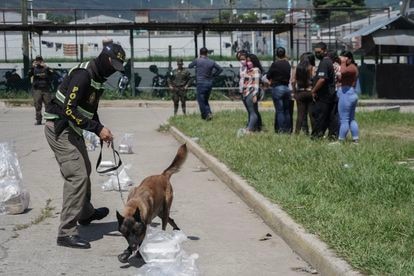
In Honduras, alluding to Bukele’s model is very effective. But, even amidst the state of emergency, many Hondurans compare life in Tegucigalpa —the capital— to an open-air prison. Armed robberies and kidnappings occur on a daily basis. There are taxi stands that pay extortion fees to up to seven different groups. Pharmacies keep cash in vaults. The streets are filled with tinted windows and the shantytowns are still controlled by the gangs.
Local media constantly narrates the massacres in the country: four were killed, five were killed, an entire family was killed. 23 truck drivers have been hijacked and shot in the past nine months. The first crime against environmentalists in 2023 occurred in Honduras: Jairo Bonilla and Aly Domínguez —who were defending the Guapinol River against a mining company— were shot to death. Eight other environmentalists have subsequently been murdered. All of these crimes occurred during a 10-month-long state of emergency. And, despite the tough-on-crime stance, 90% of homicides in Honduras remain unsolved.
A graffiti message on one of the main boulevards in Tegucigalpa screams: “Xiomara’s hell.” Another tag: “We want a crackdown on gang members.” Upon assuming the presidency, Xiomara Castro —the first female president of Honduras, who served as first lady from 2009 until 2011— made an unprecedented decision: she took away security operations from the Army. She wanted to strengthen the police —an ineffective body, lacking personnel and lacking credibility among the population. But the experiment didn’t have time to take shape. “It’s no coincidence,” explains investigative journalist Jared Olson, “that a reformist woman arrives, who isn’t perfect —she also has accusations of corruption —but who says she’s going to change things and then, suddenly, the violence increases.”
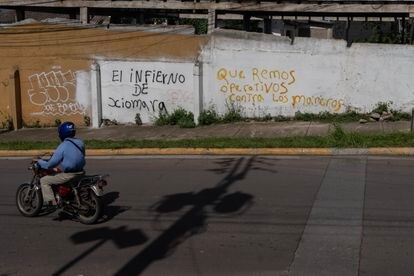
On December 6, 2022 —after a crisis caused by widespread extortion in the transportation sector— Castro reversed her position and decreed a state of emergency in half of the country, which included the largest cities and most violent municipalities. She suspended constitutional guarantees —such as freedom of movement and association— and allowed warrantless searches and arrests, with the stated goal of facilitating the investigation of crimes. The state of emergency has been extended, for now, until October 6.
The Ministry of Security —which periodically publishes the achievements of the measure— highlights that, from January to July of 2023, 375 fewer homicides have been recorded than in the same period last year. This is true: Honduras now has its lowest murder rate in 18 years. But, despite this, it still has the second-highest homicide rate in Latin America, only behind Venezuela.
“Those of us who have studied the phenomenon believe that [the homicide rate] won’t decrease much further, because [the decline] responds to a model of deterrence and control, in which the use of force is prioritized,” says security analyst Leonardo Pineda. “However, the roots of the violence aren’t being targeted. There’s a lack of access to healthcare, to education, to a decent quality of life.” In fact, in an opinion poll carried out this past July by the firm ERIC-SJ, insecurity is the population’s third-biggest concern, far behind the economic crisis and the high unemployment rate. These three issues combined are driving the increase in Honduran migrants: around a million people have left the country, representing around 10% of the population.
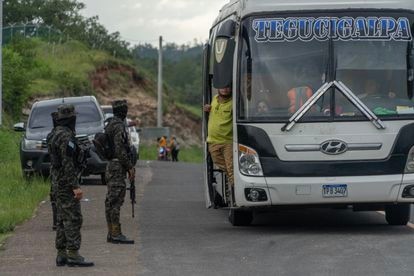
Nearly half of Honduran citizens agree with the partial state of emergency, according to a survey by the Association for a More Just Society (ASJ). But 77% of those surveyed say that they currently feel the same as before it was in place, or they feel even more insecure. Those consulted by EL PAÍS point out that, while the emergency measures exist on paper, they haven’t changed the daily life of the population for better or for worse. “[The government] has tried to follow the trend established by Nayib Bukele [in El Salvador]… but Honduras isn’t ready for something like that,” Pineda affirms. This observation is repeated by experts, journalists, citizens… and even a former gang member.
Maps have something to do with the issue. Honduras has a key geographic position in the center of the Central American isthmus: it has land borders with Guatemala, El Salvador and Nicaragua. “It’s a key country for drug-trafficking in the hemisphere. El Salvador is just a little piece of land that can be avoided… but to take cocaine from Venezuela to Mexico, you have to go through Honduras,” explains journalist Jared Olson, who has been investigating corruption and insecurity in the country for the past four years.
Furthermore, El Salvador is a territory five times smaller, with almost three times as many police officers and twice as many military personnel as Honduras. “Logistically speaking, this is a problem,” Pineda sighs. Honduras has one of the lowest police concentrations on the continent: 1.8 per 1,000 inhabitants. Panama, for example, has 5.9, while the UN recommends at least three. “We have an approximate deficit of about 17,000 police officers in the country. And, in 2022, there was a drop in earnings [for police professionals]. Young people don’t want to become police officers,” adds Nelson Castañeda, the security director at ASJ.
Honduras has also had trouble shaking the label of “narco-state.” “It’s easier for El Salvador to eliminate the gang members, because they’re of no use,” explains Olson, who now lives in Mexico City, having had to flee Honduras due to his reporting. “But in Honduras, it’s different. The security forces are handling a lot of money from drug-trafficking. They don’t want to completely eliminate the gang members, because they’re useful, they use them to commit massacres, murders. While [the security forces] allow [the gangs] to operate, they abandon communities to their fate, for entire months, even years.”
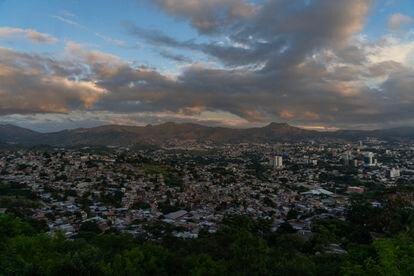
The gangs and the soldiers
He’s just a boy. He wears big glasses, a baseball cap and designer sneakers. From his position in the grocery store, he has a privileged view of Tegucigalpa. In Honduras, they call people like him “flags.” His job is to monitor the area: who enters, what car they drive, their licence plate number. Whether or not they have permission to travel through the poorly-paved streets; what purpose they’re coming for, when they’re leaving. In this district controlled by MS-13 he reports to those who are in charge.
Nothing seems to have changed much in the marginal neighborhoods since the state of emergency came into force. At least, not in practice. The unwritten rules remain the same. In the shantytowns of the Honduran capital, you cannot enter without invitation. If you’re driving, you have to keep the windows down; if you drive a motorcycle, the visor has to be up, so that your face can be seen. Phones have to be kept out of sight. Nobody asks questions. Mistakes are costly.
Since the state of emergency was decreed, the government has been eager to demonstrate the success of special operations. In a report released on July 19, the Ministry of Security boasted that the authorities had detained more than 1,300 people, about 500 allegedly related to gangs. The vast majority were arrested for crimes related to drug-trafficking, another 250 for extortion. However, according to data from the ASJ, less than half of the latter have been prosecuted: only 84 have been formally sentenced. The majority are released soon after they’re arrested. “They take them to court and [the prosecutor] cannot prove the crimes, because there are many deficiencies in the investigations and the ballistics identification system doesn’t work… they have to release them or keep them in prison without a sentence, which is just as bad. [Arresting people] has become more of a measure in response to pressure, to propagandize that ‘we’re doing something against insecurity,’” Pineda says.
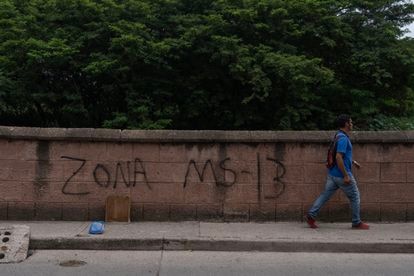
The gangs are the perfect enemy in the public imagination. “They represent all evils. But we’ve said —through the investigations [that we’ve done] since 2004— that the gangs are the hitmen and the muscle of the business, political and military leadership. They serve as cannon fodder and are the perfect excuse for a state of emergency,” emphasizes investigative journalist Wendy Funes. “You can’t understand the violence in Honduras if you’re only looking at it from the bottom: the gangs couldn’t exist without official authorization,” continues her colleague Jared Olson.
The journalists’ statements are particularly relevant in a country whose last president —Juan Orlando Hernández— is imprisoned in New York for drug-trafficking. He is accused of facilitating the entry of tons of cocaine into United States territory and of receiving millions of dollars from criminal organizations that operate both in his country and in Mexico —including the bloodthirsty Sinaloa Cartel.
“The problem of drug-trafficking didn’t go away with Juan Orlando —it’s here to stay. Drug-traffickers are using gangs as an armed wing, as hitmen,” Pineda notes. But journalists go further: it’s not just the cartels, but the institutions. “There’s an ongoing [relationship] between the state and organized crime. They use each other for their own interests. Especially the Honduran Army, which manipulates the gangs like chess pieces.”
And what’s the point of collusion between the state and criminals? The prisons. President Xiomara Castro took them away from the military, changing up the chessboard… and then June 20 arrived.
Torture in prisons
At 7:50 in the morning that day, two police officers went to take roll call in cell block #7 of the National Women’s Penitentiary for Social Adaptation (PNFAS). They opened the doors to the wing inhabited by women linked to the Barrio 18 gang and were shot at. The inmates stole their keys, their radios and their lists. They had part of their arsenal hidden in laundry buckets. They left the cell block with weapons —including AK-15s. They had one hour to kill: no security agent entered until the massacre stopped, at 8:56 AM.

In Honduras, there’s only one prison for womens. Around 900 inmates coexist within those gray walls, including members of Barrio 18 and MS-13. While there are fewer female gang members on the street, there are nearly 400 inmates belonging to the former group and about 100 belonging to the latter.
The riot was a call to war. “Bitches, we’re going to set you on fire!” The Barrio 18 inmates went directly to the cell block housing MS-13 inmates. There, several alleged MS-13 members were viciously murdered —women were left with their heads cut open with stones, or with stab wounds in their necks. The cells were burned with gasoline —28 women died. Those who survived were on the roof, like Lidesme. But the violence didn’t stop there. “They started shouting out names, they had a list. They knew how much time they had in each cell block,” says Sheila (not her real name), who was imprisoned in cell block #4 on June 20. “Josefa, we’re coming for you,” they shouted, banging on the doors.
They killed Josefa —because, as area coordinator, she hadn’t allowed them to sell drugs— and they murdered her daughter, the church coordinator. They also killed “another woman, who they said also belonged to the MS-13,” Sheila whispers. “She begged them not to kill her, she cried for her children, but they were devils.” The rioting inmates also murdered two imprisoned former police officers. The death toll rose to 46. Only three of the dead women had been convicted of homicide. The majority were in prison for living in areas controlled by the MS-13, as an investigation by anthropologist Juan Martínez has revealed. To this day, there’s still no official list of who the deceased were. The state has paid their families 50,000 Honduran lempiras —or $2,500— in compensation.
“The police arrived and only saw the dead,” Sheila laments. She points out that the aggressors had time to put away their weapons. Two weeks later, the military arrived. And, two months later, Mayra and July are selling cushions outside the prison. There’s no way to shake off the sadness of June 20, nor the fear. They spend their time in the workshops —which offer a livelihood for the inmates— where they fill, paint and sew cushions. To get to the work area, however, the women have to cross the patios where those from Barrio 18 are housed. The attackers and the victims continue living behind the same walls, in what is clearly a ticking time bomb.
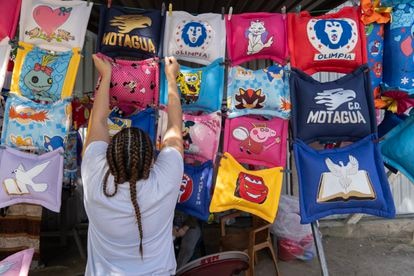
Mayra says that she feels safer with the military there, although she cries because she can no longer speak with her children, only with her parents. Women have the right to a three-minute call every 15 days. In some men’s prisons, the inmates don’t even get that.
In one notorious male prison in Honduras —El Porvenir— wives come out distraught. During the highly-restricted visiting hours, women have seen their husbands without toenails, with wire slits in their soles, with bruises on their backs and abdomens. They emerge from their cells as skinny as skeletons. They say they don’t have medicine and they don’t get sunlight —that they eat bugs to survive. Sometimes, they spend days lying on cots without mattresses, recovering from beatings. Women have complained that they are forced to strip and squat before being able to visit their loved ones— after travelling for hours and hours— for around 10 minutes. They come out of the jail crying: “They did something wrong and they’re already serving their sentences… but is it necessary to treat them like animals?”
Reports of torture in prisons have skyrocketed since the facilities were returned to the control of the Army. Corruption has resulted in Honduran jails becoming centers for organized crime — gang leaders order hits and extortion from their cells. The prisons, Wendy Funes explains, “make up the [strong-arm] of the narco-state.”
Honduran jails are also a hotbed of human rights abuses —journalists and NGOs are forbidden from entering. These institutions most resemble the Bukele administration in El Salvador. As Funes says: “The military has made a cheap copy of the prisons of El Salvador. Until now, the state of emergency has only been an emergency response, a show, a measure taken [in response] to public opinion. But if the entire security issue is handed over to the military, then we have a real risk.”
Sign up for our weekly newsletter to get more English-language news coverage from EL PAÍS USA Edition
This post was originally published on this site be sure to check out more of their content.






